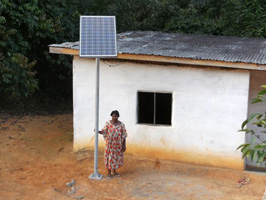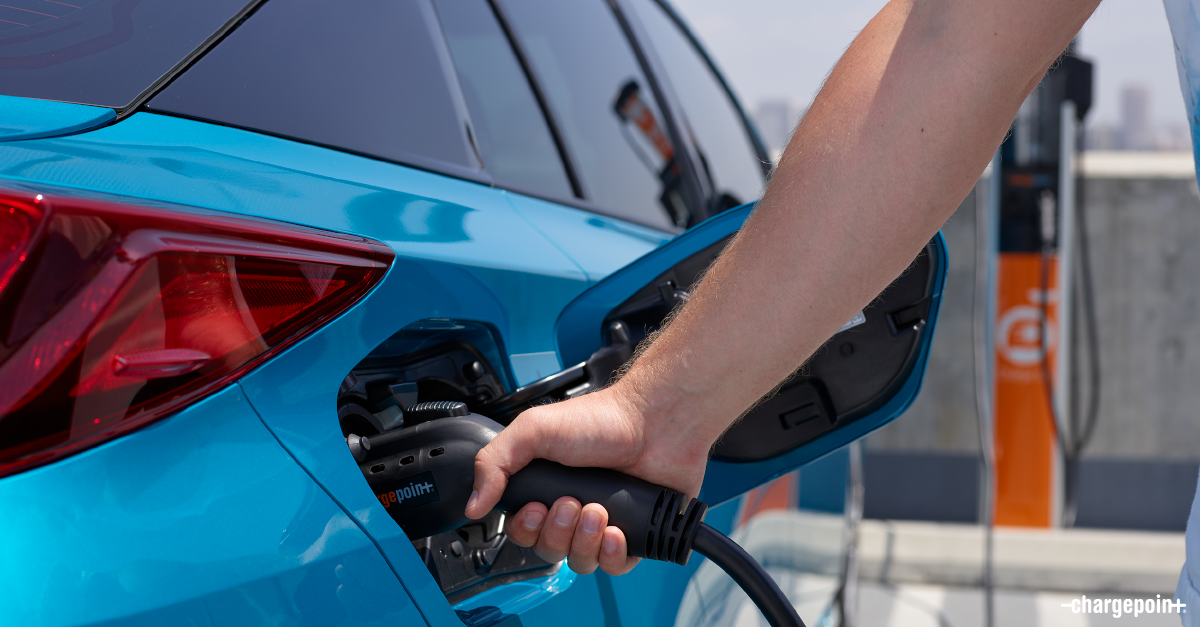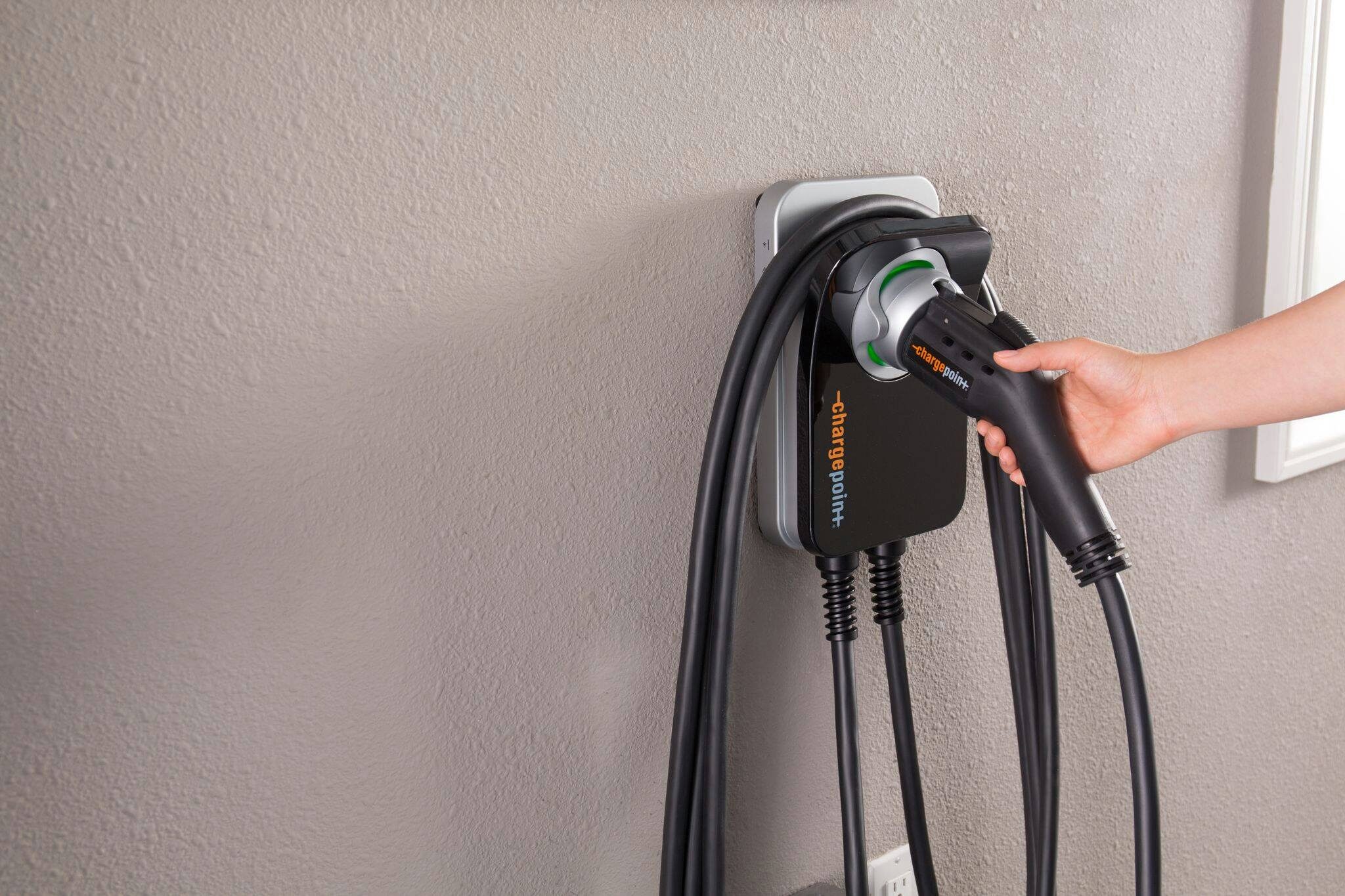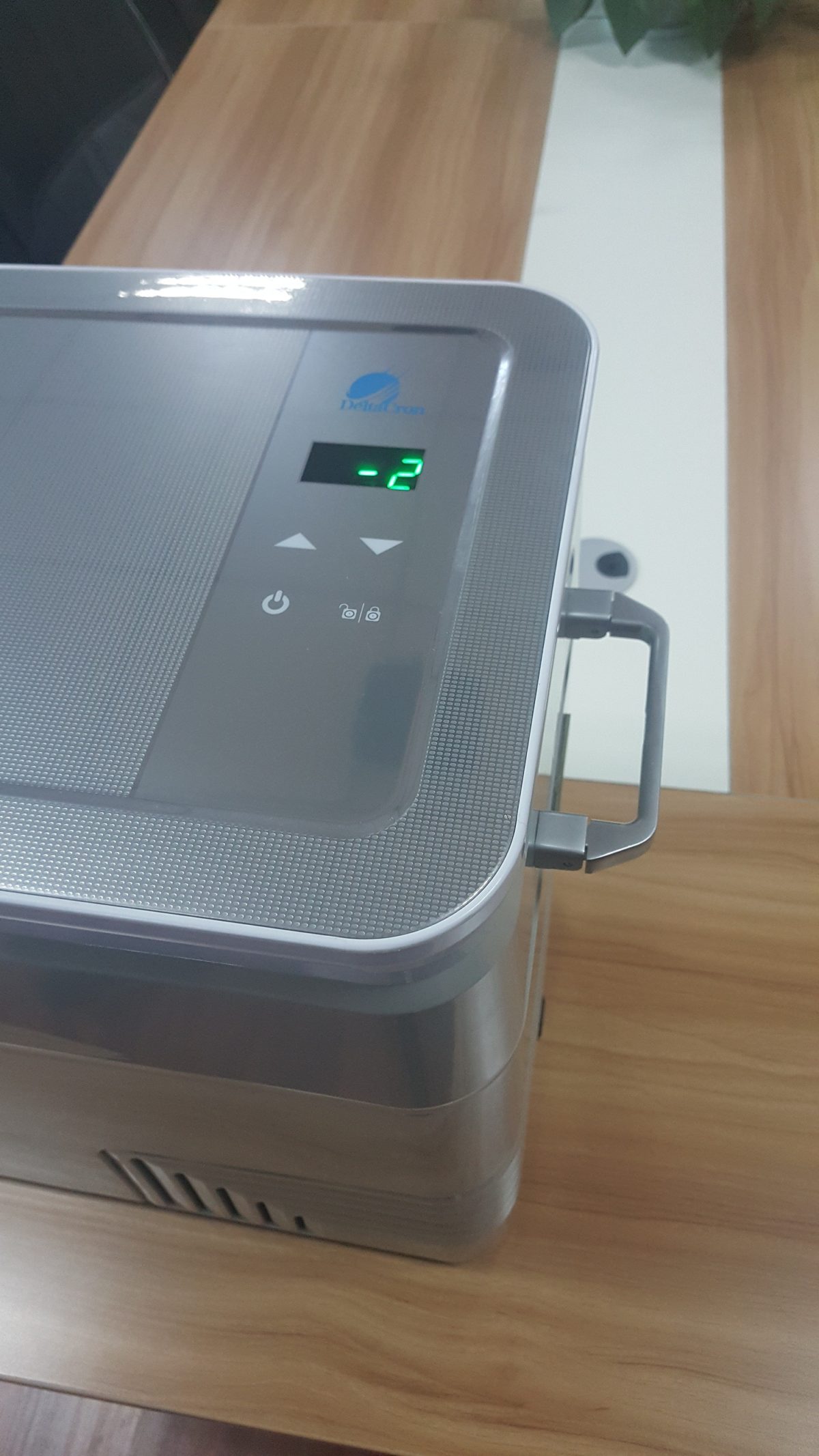Summer is is here and it’s almost time to pull out those camp chairs, swimsuits and above all, the chilled drinks on the beach!
We are proud to bring to you our latest addition to our solar products, The Solar Powered Cooler!
This portable 25 litre cooler has a temperature range of +10 to -20 degrees celsius. With its in-built custom made Samsung lithium battery, it can work with no external power for up-to 12 hours on a single charge. This battery can be charged in 3 ways; 12V car charge, 120/220V wall charge and Solar power from its attached 100W solar panels. This feature alone, makes its the only cooler on the market that can run constantly in an area that completely has no grid power.
Made from recyclable material, this portable cooler comes in at a gross weight of 10.6Kg and a net weight of 8.2Kg! Its patent pending “Stand Alone” portable solar technology makes its second to non, as there is nothing like this on the market.
With this cooler, you can surely forget about the price of ice at the gas station this summer, and the many more summers to come!
At Deltacron, we will continue to bring to you products that are environmentally friendly coupled with the latest technology!
Month: August 2018
Canada should hold firm and reject Trump’s efforts to roll back vehicle standards
VICTORIA — Dan Woynillowicz, policy director at Clean Energy Canada, made the following statement in response to the U.S. federal government’s proposed rollback of vehicle emission standards:
“It’s in Canadians’ best interest that our federal government reject Trump’s rollback and stick with the rules currently in place. Otherwise, Canadian drivers won’t benefit from $900 a year in fuel cost savings. We also need to protect our climate and the air quality in our cities. The technology exists, the costs to car companies are reasonable, and the benefits are clear.
“More efficient, cleaner vehicles are creating jobs for Canadians—that’s why most auto suppliers support the standards. Last year Linamar, the second largest Canadian auto parts manufacturer, had record sales and earnings, driven in part by a huge contract to produce axles for electric vehicles.
“If you look around the world, it’s clear that hybrid and electric vehicles are set to become the new norm. Car companies in Germany and China are racing toward that fast-approaching future. Countries like the U.K. and France, meanwhile, are banning gas- and diesel-powered vehicles within a couple decades. We now have an opportunity to ensure the right signals are sent to the Canadian auto sector—an opportunity to ensure we thrive in the years to come.”
KEY FACTS
When the current standards were adopted in 2012 by Prime Minister Stephen Harper’s government, it was noted that:
- 2025 vehicles will consume up to 50% less fuel than 2008 vehicles.
- On average, a Canadian driving a model year 2025 vehicle will realize fuel savings of around $900 per year compared to driving a 2012 model vehicle.
- 2025 model year vehicles will emit close to 50% less greenhouse gas pollution than 2008 vehicles
Other key facts:
- The 2012 regulatory impact analysis found that while a more fuel-efficient vehicle would likely have a slightly higher sticker price at the dealership, drivers would break even after two years, beyond which they would continue to benefit from lower fueling costs.
- A majority of U.S. auto suppliers back the current standards, and the head of the Canadian Automotive Parts Manufacturers’ Association has signalled concern with a potential rollback, stating, “We have been investing hundreds of billions of dollars in lightweighting and also alternative propulsion…. If that standard is lowered, at this late stage, in some cases, it threatens to strand some of that advanced research and development spending.”
Cheap Energy Source for Africa.
Kerosene lamps and sore eyes were once routine elements of grading student homework. Solar electricity has changed that. Caroline Hombe, a 35-year-old teacher in rural Mhondoro, Zimbabwe, can go through the pile of books stacked on her table without worrying that the onset of darkness will put an end to her work. African countries, blessed with sunlight all year round, are tapping this free and clean energy source to light up remote and isolated homes that have no immediate hope of linking to their national electricity grid.
“My eyes were always painful and my head ached from the fumes,” Ms. Hombe told Africa Renewal. “Imagine trying to go through a hundred exercise books in poor lighting and smoke. The alternative was marking assignments before sunset, but that meant I could not spend time with my two young children before their bedtime, or prepare dinner early enough. Thankfully, this is now a headache of the past.”
 Electrifying rural areas poses unique challenges for African governments. Remote and scattered, rural homes, unlike homes in urban areas, are costly and often impractical to connect to the grid. Under the New Partnership for Africa’s Development (NEPAD), countries are seeking innovative alternatives to give rural families efficient means to cook their food and light their homes. Stand-alone sources of energy, such as solar, wind and mini-hydro generators, can help fill the gap.
Electrifying rural areas poses unique challenges for African governments. Remote and scattered, rural homes, unlike homes in urban areas, are costly and often impractical to connect to the grid. Under the New Partnership for Africa’s Development (NEPAD), countries are seeking innovative alternatives to give rural families efficient means to cook their food and light their homes. Stand-alone sources of energy, such as solar, wind and mini-hydro generators, can help fill the gap.
NEPAD, Africa’s development blueprint, recognizes that to achieve the desired social and economic prosperity, countries must boost access to cheaper and reliable energy. Excluding South Africa and Egypt, no more than 20 per cent (and in some countries as few as 5 per cent) of Africans have electricity. This figure falls to an average of 2 per cent in rural areas where the majority of Africans live — a far cry from the 35 per cent consumption level, or more, African leaders wish to achieve.
‘The sun is free’
The target is quite feasible, says Mr. Garai Makokoro, director of the Energy Technology Institute in Zimbabwe. Africa, after all, possesses some of the world’s largest watercourses (hydro-potential), as well as some of the world’s largest oil, coal and gas reserves. The way to move the NEPAD vision ahead, he adds, is for countries to find cheaper power sources while minimizing environmental hazards and ensuring sustainability. The energy expert believes that solar power, clean and renewable, fits the bill.
“African countries must think outside the box. The sun is free and inexhaustible. Solar technology — photovoltaic panels — converts the sun’s radiation directly into electricity with no pollution or damage to the environment. The panels can generate enough power to run stoves, pump water, light clinics and power televisions. Africa has one of the best climates for this type of energy,” Mr. Makokoro.
But even with the compelling advantages solar power offers, the Human Development Report, published by the UN Development Programme (UNDP), shows that the majority of Africans still rely on less efficient traditional energy sources. Wood, or other biomass such as crop waste, is the dominant fuel for cooking. This comes at a huge cost to the environment as families continue to cut down trees for much-needed fuel.
In the early 1990s, numerous villages turned to solar power in parts of Africa where one might least expect to stumble upon an oasis of lights shimmering in the pitch-black night. Perhaps the most ambitious project of this nature, and one that is often cited, is a Zimbabwean project supported by UNDP through the Global Environment Facility (GEF). The initiative, jointly funded by GEF ($7 mn) and Zimbabwe ($400,000), installed some 9,000 solar power systems throughout the country in a bid to improve living standards, but also to curtail land degradation and pollution.
The River Estate near Shamva, 70 kilometres from Zimbabwe’s capital, Harare, boasts one of the best solar-village models in the country. Fifty-two commercial farming families share systems there is one system for every two houses. Each family has two lamps and a connection for a radio or small television set. The new lighting systems have improved the quality of life for the community. They have extended study hours for schoolchildren, reduced rural-to-urban migration in the area and upgraded health standards by electrifying a local health center.
Innovative financing
“With all their advantages, solar systems are not cheap to install,” says Mr. Jem Porcaro, an analyst for the Energy and Environment Group at UNDP. “A typical home system in sub-Saharan Africa costs anywhere between $500 and $1,000 and such systems typically provide enough power to light three to six rooms and power a black-and-white TV each night. But the cost is well beyond the means of most African households.”
The use of innovative financing schemes, like fee-for-service arrangements, is one way to overcome these high up-front costs, notes Mr. Porcaro. Installing solar panels to power multiple houses at once can also cut down on costs. More households could afford solar power, argues the World Bank, if governments were to remove barriers, such as high import duties, that increase the cost of the panels. Regional cooperation to facilitate trade is another major NEPAD goal.
African leaders are demonstrating commitment to bring solar power to rural homes. For example, a UNDP-GEF report on solar financing and delivery models notes that private sales, through dealers, initially dominated the market in South Africa, but that the government, a leading NEPAD proponent, later initiated a massive off-grid effort that is now fully active. Botswana, Namibia, Swaziland, Zambia and most countries in the region have developed solar markets, in many cases with special funds to support consumer credit.
Boost to businesses
Besides domestic use, people are harnessing solar power to run small businesses. Entrepreneur Abina Lungu operates a maize-grinding mill in Nyimba, eastern Zambia. With reliable solar energy, he can work well into the night to meet all his customers’ orders. His house, close to the mill, is also lit by solar power. Mr. Lungu is one of the many villagers serviced by the Nyimba Energy Service Company (NESCO), an enterprise funded by the Swedish International Development Agency. To get power into a home or shop, NESCO installs a system that includes a panel, battery, charge controller and power points. The cost is $33.33, including the contract fee. Thereafter, consumers pay a monthly rental fee.
“I pay 30.0 kwacha [about $6.25] as a rental charge every month to NESCO,” Mr. Lungu told the Integrated Regional Information Networks (IRIN), a humanitarian news agency. “For me, it works out cheaper to use solar because paraffin is more expensive, and even if electricity comes to Nyimba, not all the people will get connected.”
As we continue opening up markets in Africa, we at DeltaCron have realized how little marketing is needed to convince African citizens to turn to solar. The demand is high. African citizens require both small solar equipment to large scale equipment. For this reason, DeltaCron continues to bring quality solar products of all sizes to meet how new customers demands.
Electric Vehicle Charging Ports
With the improvement in technology and drop in prices, but increase in gas prices, more drivers are choosing to go with Electric Vehicles (EV). By 2035, it is estimated 65% of vehicles sold in Canada will be EV, and a total of 85% plus will be Hybrid or fully electric. To fully benefit from these vehicles, a good, affordable, but most importantly, reliable charging port is important. The availability of these ports is also important. Drivers need not to be limited on where, or how far they can travel due to the scarcity of charging ports.
When installed by a certified installer like ourselves, these charging stations are reliable, safe, and easy to use. In addition to the convenience of choosing when to charge, they give you an opportunity to choose whether to use a fast charge port or, if you have some time to kick around the charge port location, a slow charge.

Deltacron Tech has partnered with manufacturers that have a vast network of commercial charging ports making it easy for many drivers to find a port when needed. Our experience and reputation in the renewable energy industry has make it easier for our partners to trust us with installation of these charging ports.
For this reason, Deltacron Tech has combined its expertise in Solar Photovoltaic with that of electric car charging installation ports. Our technicians have had the training from the manufacturers of the charging ports and are licensed and backed by the manufacturers.
At Deltacron, we also offer level 1 charging port supply and installation services. These charging stations use a normal 120-volt connection, which uses any standard household outlet. These charger usually are not bulky and can be kept in the trunk of the vehicle for on the go charging depending on where the driver finds an outlet.
We also have the level 2 charging ports.  These EV chargers use a higher-output 240-volt power source, like the one that you plug your oven or clothes dryer into. Charging times are much faster than with a Level 1 EV charging station. These are installed in the clients home which he/she can use to charge their vehicle while parked at home. Most EV car drivers have these installed for night time charge as they can benefit from the slow charge.
These EV chargers use a higher-output 240-volt power source, like the one that you plug your oven or clothes dryer into. Charging times are much faster than with a Level 1 EV charging station. These are installed in the clients home which he/she can use to charge their vehicle while parked at home. Most EV car drivers have these installed for night time charge as they can benefit from the slow charge.
For the charger that suits your needs, get in touch with one of our associates to discuss.
Solar Grid-Tied and Off-grid Systems
Off grid powered homes hospitals and schools are becoming more and more popular for people who live in remote locations where power outages frequently occur. The above off-grid solar installation uses 24 PV solar panels tied to a battery bank of 12 batteries for approximately 16 kWh worth of daily use.
Off grid systems are being used to power critical loads in homes. An example of critical loads which can be supported by the off-grid solar system includes refrigeration, electric or induction cook top, interior lighting, exterior security lighting, and a cell phone charger. Additional non-essential loads can be tied to the battery bank as well. These are also designed based on customer needs, but normally include small appliances such as an electric fan TV decoders.
The off-grid system will provide daily power supply via a battery bank connected to and recharged by solar PV panels.
Solar Water Pumps
Solar water pumps enable you to move water from its remote source to where you need it, without access to power lines. Solar pumping has three primary uses; domestic use for washing, cooking and drinking, livestock watering, and irrigation. The same basics are used for all three requirements, although domestic use may require additional capabilities. Solar water pumps are often used in remote areas where the cost of running traditional water piping is cost prohibitive or you just want to provide water to an off-grid home. Solar water pumping systems are also used to pump water for livestock and crop irrigation
At Deltacron Technologies, we bring you two types of water pumps, submersible pump and surface pump. A submersible pump is installed under water, usually in a well, but can also be in a pond or stream if raised off the bottom. A surface pump is installed above the water, with an intake hose feeding the pump from the water source, and the output hose feeding the tank. Pumps are able to push water out much higher than they are able to suck water in, so the they need to be close to the water source. Keep the head, or the height difference between the water and the pump, as low as possible.
Solar Powered Coolers
Our portable solar powered coolers gives you the freedom to bring your chilled drinks and food to anywhere you like, no-matter what the power situation in the area is.
The portable 25 litre cooler (grey) and its older sister 50 litre cooler (off black) have a temperature range of +10 to -20 degrees celsius. With their in-built custom made Samsung lithium batteries, they can work with no external power for up-to 12 hours on a single charge. This battery can be charged in 3 ways; 12V car charge, 120/220V wall charge and Solar power from its attached 100W solar panels. This feature alone, makes them the only cooler on the market that can run constantly in an area that completely has no grid power.
charged in 3 ways; 12V car charge, 120/220V wall charge and Solar power from its attached 100W solar panels. This feature alone, makes them the only cooler on the market that can run constantly in an area that completely has no grid power.
Made from recyclable material, these portable coolers come in at a gross weight of 10.6Kg and 12.1Kg gross and a net weight of 8.2Kg and 9.6Kg respectively! Their patent pending “Stand Alone” portable solar technology makes them second to non, as there is nothing like this on the market.
With these coolers, you can surely forget about the price of ice at the gas.







